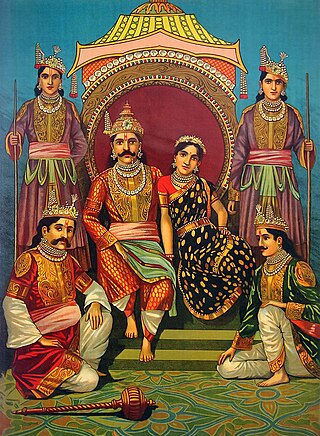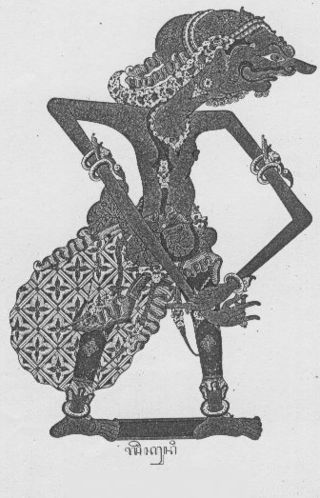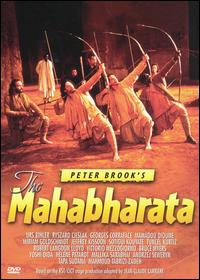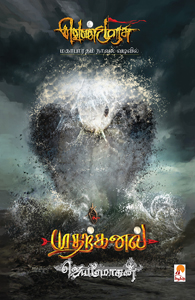
The Mahābhārata is one of the two major Smriti texts and Sanskrit epics of ancient India revered in Hinduism, the other being the Rāmāyaṇa. It narrates the events and aftermath of the Kurukshetra War, a war of succession between two groups of princely cousins, the Kauravas and the Pāṇḍavas.

Draupadi, also referred to as Krishnā, Panchali, and Yajnaseni, is the main female protagonist of the Hindu epic Mahabharata, and the wife of the five Pandava brothers—Yudhishthira, Bhima, Arjuna, Nakula, and Sahadeva. She is noted for her beauty, courage, and polyandrous marriage.

Duryodhana, also known as Suyodhana, is the primary antagonist in the Hindu epic Mahabharata. He was the eldest of the Kauravas, the hundred sons of the king Dhritarashtra and his queen Gandhari.

Karna, also known as Vasusena, Anga-raja, and Radheya, is one of the main protagonists of the Hindu epic Mahābhārata. He is the son of the sun god Surya and princess Kunti, and thus a demigod of royal birth. Kunti was granted the boon to bear a child with desired divine qualities from the gods and without much knowledge, Kunti invoked the sun god to confirm it if it was true indeed. Karna was secretly born to an unmarried Kunti in her teenage years, and fearing outrage and backlash from society over her premarital pregnancy, Kunti had no choice but to abandon the newly born Karna adrift in a basket on the Ganges, in the hope that he finds foster parents. The basket is discovered, and Karna is adopted and raised by foster Sūta parents named Radha and Adhiratha Nandana of the charioteer and poet profession working for king Dhritarashtra.

Yudhishthira also known as Dharmaraja, was the king of Indraprastha and later the Kuru Kingdom in ancient Indian History and the eldest among the five Pandava brothers, he is also one of the central figures of the ancient Hindu epic Mahabharata.

Shakuni is one of the antagonists of the Hindu epic Mahabharata. He was the prince of the kingdom of Gandhara when introduced, later becoming its king after the death of his father, Subala. He was the brother of Gandhari and the maternal uncle of the Kauravas.

Mohini is the Hindu goddess of enchantment. She is the only female avatar of the Hindu god Vishnu. She is portrayed as a femme fatale, an enchantress, who maddens lovers and demons, sometimes leading them to their doom. Mohini is introduced into Hinduism in the narrative epic of the Mahabharata. Here, she appears as a form of Vishnu following the Churning of the Ocean, a mesmerising beauty who distributes the amrita to the weakened devas (gods) and depriving it to the dominant asuras (demons), allowing the former to defeat the latter with their newfound immortality.

Koothu or Therukoothu (jwalith), is an ancient art, where artists play songs with dance and music in storytelling the epics, performed in Tamil; it is a folk art originated from the early Tamil country. More precisely Koothu refers to either Terukuttu (Tamil:தெருக்கூத்து) or Kattaikkuttu. The terms Terukkuttu and Kattaikkuttu are often used interchangeably in modern times; however, historically, the two terms appear to have distinguished, at least in certain villages, between two different kinds of performance: while Terukkuttu referred to mobile performances in a procession, Kattaikkuttu denotes overnight, narrative performances at a fixed performance space. Koothu as a form of entertainment reached its peak hundreds of years ago in Tamil Nadu, as mentioned in the Sangam texts about the development of iyal (literature), isai (music) and natagam (drama). Going beyond just a means of entertainment, koothu educates the rural people about religion and their history.
Koovagam is a village in the Ulundurpettai taluk in Kallakurichi district, Tamil Nadu. It is famous for its annual festival of transgender individuals, which takes fifteen days in the Tamil month of Chitrai (April/May).

Iravan also known as Iravat and Iravant, is a minor character from the Hindu epic Mahabharata. The son of Pandava prince Arjuna and the Naga princess Ulupi, Iravan is the central deity of the cult of Kuttantavar (Kuttandavar) which is also the name commonly given to him in that tradition—and plays a major role in the sect of Draupadi. Both these sects are of Tamil origin, from a region of the country where he is worshipped as a village deity and is known as Aravan. He is also a patron god of well-known transgender communities called Alis.

Kunti, born Pritha, is a prominent figure in the Hindu epic Mahabharata. Recognized for her pivotal role as the mother of Karna and the Pandavas, the central protagonists of the narrative, she is depicted as possessing notable beauty, intelligence, and shrewdness.

The Vanniyar, also spelled Vanniya, formerly known as the Palli, are a Dravidian community or jāti found in the northern part of the Indian state of Tamil Nadu.

Mahabharat is an Indian Hindi-language epic television series based on the ancient Sanskrit epic Mahabharata. The original airing consisted of a total of 94 episodes and were broadcast from 2 October 1988 to 24 June 1990 on Doordarshan. It was produced by B. R. Chopra and directed by his son, Ravi Chopra. The music was composed by Raj Kamal. The script was written by Pandit Narendra Sharma and the Hindi/Urdu poet Rahi Masoom Raza, based on the epic by Vyasa. Costumes for the series were provided by Maganlal Dresswala. The serial claims to have used the Critical Edition of Bhandarkar Oriental Research Institute as its basic source with Vishnu Sitaram Sukthankar and Shripad Krishna Belwalkar as its primary editor.

The Mahabharata is a 1989 film version of the Hindu epic Mahabharata directed by Peter Brook. Brook's original 1985 stage play was 9 hours long, and toured around the world for four years. In 1989, it was reduced to under 6 hours for television. Later it was also reduced to about 3 hours for theatrical and DVD release. The screenplay was the result of eight years' work by Peter Brook, Jean-Claude Carrière and Marie-Hélène Estienne.

Kattaikkuttu is a rural theatre form practised in the State of Tamil Nadu in South India. The performers – by tradition only men – sing, act and dance and the musicians accompany them on the harmonium, the mridangam and the mukavinai. The terms Terukkuttu and Kattaikkuttu are often used interchangeably. However, historically the two terms appear to have distinguished, at least in certain villages, between two different kinds of performance: while Terukkuttu referred to mobile performances by two actors participating in a procession for the village deity Mariamman, Kattaikkuttu denotes overnight, narrative performances at a fixed performance space acted by an ensemble of about fifteen actors and musicians.

Karnan is a 1964 Indian Tamil-language Hindu mythological film produced and directed by B. R. Panthulu. It stars Sivaji Ganesan leading an ensemble cast consisting of N. T. Rama Rao, S. A. Ashokan, R. Muthuraman, Savitri, Devika and M. V. Rajamma. The film is based on the story of Karna, a character from the Hindu epic Mahabharata.
The Mahabharata is a French play, based on the Sanskrit epic Mahābhārata, by Jean-Claude Carrière, which was first staged in a quarry just outside Avignon in a production by the English director Peter Brook. The play, which is nine hours long in performance, toured the world for four years. For two years the show was performed both in French and in English. The play is divided into three parts: The Game of Dice, The Exile in the Forest and The War. In 1989, it was adapted for television as a six-hour mini series. Later, it was reduced to about three hours as a film for theatrical and DVD release. The screenplay was the result of eight years' work by Peter Brook, Jean-Claude Carrière, and Marie-Hélène Estienne.

Venmurasu is a Tamil novel by writer Jeyamohan. A modern renarration of the Indian classical epic Mahabharata, it is considered Jeyamohan's most ambitious work to date, with "a scope and scale that seeks to match the grandness of the epic itself." It is one of the longest novels ever published. Jeyamohan started writing the work in January 2014 and announced plans to write it every day over ten years. He completed Venmurasu in 2020, spanning 26 volumes and 26,000 pages.
Alfred John Hiltebeitel was Columbian Professor of Religion, History, and Human Sciences at George Washington University in Washington, D.C., US. His academic specialism was in ancient Sanskrit epics such as the Mahabharata and Ramayana, together with Indian religious tradition and folklore.
















